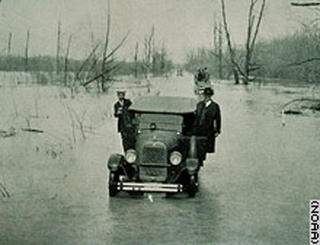
The warning signs were there... preempting and defined. But the people, the victims, the evacuees effected by the flood in 1927 were not able to get a satellite view or even a birds eye view, for that matter, of the oncoming disaster that would hit them in the hours to come.
This is the story of the Louisiana disaster in 1927The Great Mississippi Flood in 1927
was the most destructive river flood in United States history.
In the Great Mississippi Flood of 1927 the Mississippi River broke out of its levee system in 145 places and flooded 27,000 square miles or about 16,570,627 acres (70,000 km²). The area was inundated up to a depth of 30 feet (10 m). The flood caused over $400 million in damages and killed 246 people in seven states.
The flood affected Arkansas, Illinois, Kentucky, Louisiana, Mississippi, and Tennessee with Arkansas being hardest hit with 13% of its territory covered by floodwaters.
The flood began when heavy rains pounded the central basin of the Mississippi in the summer of 1926. By September the Mississippi's tributaries in Kansas and Iowa were swollen to capacity. On New Year's day of 1927 the Cumberland River at Nashville topped levees at 56.2 feet (17 m).
By May of 1927 the Mississippi River below Memphis, Tennessee was a watery oval up to 60 miles wide (100 km).
As the flood approached New Orleans, Louisiana 30 tons of dynamite were set off on the levee at Caernarvon, Louisiana and sent 250,000 ft³/s (7,000 m³/s) of water pouring through. This prevented New Orleans from experiencing serious damage but destroyed much of the marsh below the city and flooded all of St. Bernard Parish. As it turned out, the destruction of the Caernarvon levee was unnecessary; several major levee breaks well upstream of New Orleans, including one the day after the dynamiting, made it impossible for flood waters to seriously threaten the city.
By August 1927 the flood subsided. During the disaster 700,000 people were displaced, including 330,000 African-Americans who were moved to 154 relief camps. Over 13,000 refugees near Greenville, Mississippi were gathered from area farms and evacuated to the crest of an unbroken levee, and stranded there for days without food or clean water, while boats arrived to evacuate white women and children. Many African-Americans were detained and forced to labor at gunpoint during flood relief efforts.
Several reports on the poor situation in the refugee camps, including one by the Colored Advisory Commission by Robert Russa Moton, were kept out of the media at the request of Herbert Hoover, with the promise of further reforms for blacks after the presidential election. When he failed to keep the promise, Moton and other influential African-Americans helped to shift the allegiance of black Americans from the Republican party to Franklin Delano Roosevelt and the Democrats.
Politics, then and now. Would it not have been wiser to set politics and the accusations aside and simply help the people.
----------------------------------------
Our hearts go out to the disaster victims and families effected by the great flood of September 2005. God Bless.

